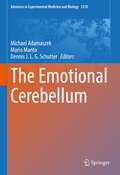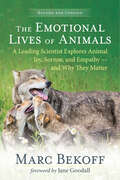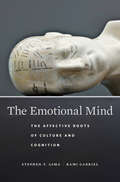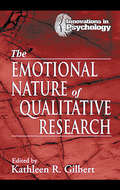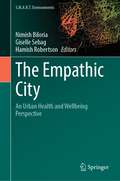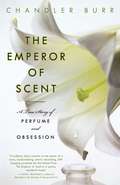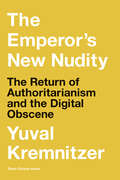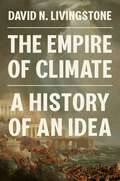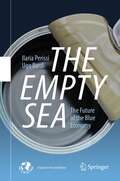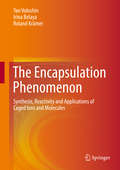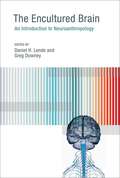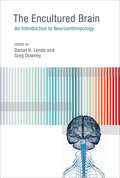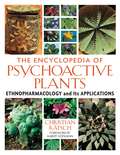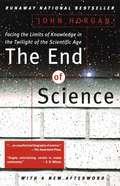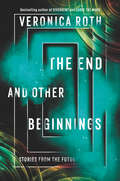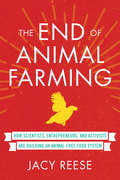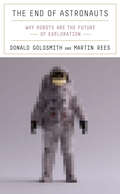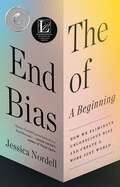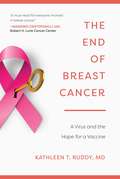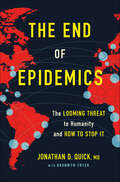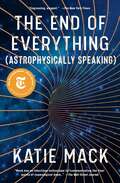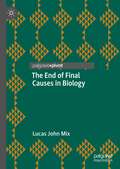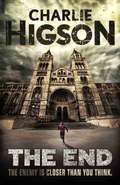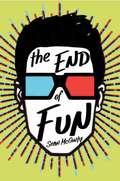- Table View
- List View
The Emotional Cerebellum (Advances in Experimental Medicine and Biology #1378)
by Mario Manto Michael Adamaszek Dennis J. L. G. SchutterEmotions represent a critical aspect of daily life in humans. Our understanding of the mechanisms of regulation of emotions has increased exponentially these last two decades. This book evaluates the contribution of the cerebellum to emotion. It outlines the current clinical, imaging and neurophysiological findings on the role of the cerebellum in key aspects of emotional processing and its influence on motor and cognitive function and social behavior.In the first section, the reader is introduced to the contributions of the cerebellum to various emotion domains, from emotion perception and recognition to transmission and encoding. Subsequent chapters provide a comprehensive picture of the neurophysiology and topography of emotion in the cerebellum and illustrate the convergence of theoretical and empirical research. Additional chapters address the cerebellum's involvement in emotional learning, emotional pain, emotional aspects of body language and perception, and its relations to social cognition including morality, music, and art. Finally, neuropsychiatric aspects of the cerebellum's influence on mood disorders and the current state of therapeutic options, including noninvasive stimulation approaches, complete the overview. This is the first book summarizing the current state of knowledge on the contribution of the cerebellum to important aspects of emotion. It is an essential reference for students, trainees, neuroscientists, researchers, and clinicians in neuroscience, neurology, neurosurgery and psychology involved in the study of emotions. The authors are renowned scientists in the field of cerebellar research.
The Emotional Lives of Animals (revised): A Leading Scientist Explores Animal Joy, Sorrow, and Empathy — and Why They Matter
by Marc BekoffA seminal exploration of animal emotion, sentience, and cognition, revised and expanded to incorporate a surge of new science When award-winning scientist Marc Bekoff penned the first edition of this book in 2007, he predicted that over time our understanding of animal cognition and emotion would grow “richer, more accurate, and possibly different.” Since then, not only has the field seen an explosion of new and startling research, but the popular interest in the subject has grown as well, spawning countless podcasts, articles, and bestselling books. Bekoff skillfully blends extraordinary stories of animal joy, empathy, grief, embarrassment, anger, and love with the latest scientific research confirming the existence of emotions that common sense and experience have long implied. Filled with light humor and compassion, The Emotional Lives of Animals is a clarion call for reassessing both how we view and how we treat animals.
The Emotional Mind: The Affective Roots of Culture and Cognition
by Stephen T. AsmaFor 200 million years before humans developed a capacity to reason, the emotional centers of the brain were hard at work. Stephen Asma and Rami Gabriel help us understand the evolution of the mind by exploring this more primal capability that we share with other animals: the power to feel, which is the root of so much that makes us uniquely human.
The Emotional Nature of Qualitative Research
by Kathleen R. GilbertThis book focuses on the place sand purpose of emotions in the research process, and explores the appropriate boundaries. Designed to explore how to manage the emotional content of research, the text service as a supplemental to qualitative research method courses, and is an excellent reference for the professional as well.
The Empathic City: An Urban Health and Wellbeing Perspective (S.M.A.R.T. Environments)
by Nimish Biloria Giselle Sebag Hamish RobertsonThis book has a primary focus on inclusions for solutions to problems and not just more on the nature of the current and emerging problems that most other competing titles present. The book is also a true global representation of challenges and opportunities that have been encountered, addressed, and critiqued from a wide variety of contributors rather than academicians per se. In doing so, rather than focusing on techno-centric prowess and associated case studies of the west (as is the case in most competing titles), the book also equally emphasizes upon the vulnerabilities and mitigating solutions being developed and tested in the under-developed and developing nations. Besides this, the book also acquires an ‘Equity’ oriented focus and hints upon sustainable, inclusive modes of shaping our built environment throughout the contributing chapters. The book is also unique in the way it combines the chosen themes to provide a holistic coverage of the broader determinants of urban health and wellbeing, thus being better positioned to address SDG3 within one compact volume. The book also differs from a typical conference proceeding or a non-peer reviewed book since the book’s highly theme specific approach is curated by a scientific peer review committee to carefully maintain diversity of contributions to the book. Cities have a profound power to support or hinder human health and wellbeing in countless ways. Achieving greater health equity has emerged in recent years as a key priority and consideration when designing cities to promote health and wellbeing, although there is a dearth of evidence and practical examples of research translation to guide cities and communities. The book accordingly exemplifies a pluralistic approach to achieving urban health equity which recognises and addresses critical aspects of geography, age, race, background, socioeconomic status, disability, gender etc. With interdisciplinary science clearly pointing to the role of the neighbourhood environment as one of the most important health determinants, this book will undoubtedly lead the next generation of urban health actors to build contextually responsive, equitable, empathic cities to benefit residents around the world. The book, rather than being focused purely on academic propositions for building equitable cities, offers a unique multi-stakeholder perspective by collaborating with the International Society for Urban Health’s 18th International Conference on Urban Health. This unique collaboration allows access to hundreds of scientists, architects, urbanists, multilaterals, policymakers, non-profit leaders, and grassroots organizers. The book captures the voices and concerns of such diverse cross-sectoral professionals and showcases findings that turn evidence into action and impact in communities around the world.Chapter 14 is available open access under a Creative Commons Attribution 4.0 International License via link.springer.com.
The Emperor of Scent: A True Story of Perfume and Obsession
by Chandler BurrThe Emperor of Scent tells of the scientific maverick Luca Turin, a connoisseur and something of an aesthete who wrote a bestselling perfume guide and bandied about an outrageous new theory on the human sense of smell. Drawing on cutting-edge work in biology, chemistry, and physics, Turin used his obsession with perfume and his eerie gift for smell to turn the cloistered worlds of the smell business and science upside down, leading to a solution to the last great mystery of the senses: how the nose works.
The Emperor's New Mind
by Roger PenroseWinner of the 1990 Science Book Prize arguing AGAINST artificial intelligence, and exploring the mystery of the mind and consciousness, Roger Penrose takes the reader on the most engaging and creative tour of modern physics, cosmology, mathematics and philosophy that has ever been written.
The Emperor's New Nudity: The Return of Authoritarianism and the Digital Obscene (Short Circuits)
by Yuval KremnitzerAn analysis of contemporary authoritarianism and the medium in which it flourishes, the internet, as well as what lies at the complex intersection of authority and technology.In recent decades, a new style of authoritarian politics has taken hold throughout the liberal-democratic world. The new authority figures are characterized by obscene, transgressive behavior, reminiscent of the &“crowd&” leader as theorized by Freud, only far less transient. In The Emperor's New Nudity, Yuval Kremnitzer considers the fraught intersection of authority and technology—the internet being the medium that has allowed contemporary authoritarianism to thrive—asking foundational questions such as: How can we think of the network as a social phenomenon? What can social and political phenomena teach us about the nature of the new technology? And how does technology reshape the very fabric of social and political life?Technology, Kremnitzer writes, leads us toward an impersonal and hyperrational world to such an extent that it renders human subjectivity outmoded. Authority, on the other hand, anchors our subjective identifications to certain figures and seems to be hopelessly primitive and irrational. What is required, then, is a dialectics of the primal—a study of the way in which what strikes us as essential enters into the dynamics of historical change. From this perspective, authority and technology can be said to be divided by a common object—the unwritten law, and the special knowledge that pertains to it: a knowledge without knowers.
The Empire of Climate: A History of an Idea
by David N. LivingstoneHow the specter of climate has been used to explain history since antiquityScientists, journalists, and politicians increasingly tell us that human impacts on climate constitute the single greatest threat facing our planet and may even bring about the extinction of our species. Yet behind these anxieties lies an older, much deeper fear about the power that climate exerts over us. The Empire of Climate traces the history of this idea and its pervasive influence over how we interpret world events and make sense of the human condition, from the rise and fall of ancient civilizations to the afflictions of the modern psyche.Taking readers from the time of Hippocrates to the unfolding crisis of global warming today, David Livingstone reveals how climate has been critically implicated in the politics of imperial control and race relations; been used to explain industrial development, market performance, and economic breakdown; and served as a bellwether for national character and cultural collapse. He examines how climate has been put forward as an explanation for warfare and civil conflict, and how it has been identified as a critical factor in bodily disorders and acute psychosis.A panoramic work of scholarship, The Empire of Climate maps the tangled histories of an idea that has haunted our collective imagination for centuries, shedding critical light on the notion that everything from the wealth of nations to the human mind itself is subject to climate&’s imperial rule.
The Empty Sea: The Future of the Blue Economy
by Ugo Bardi Ilaria PerissiThe “Blue Economy” is used to describe all of the economic activities related to the sea, with a special emphasis on sustainability. Traditional activities such as fisheries, but also undersea mining, tourism, and scientific research are included, as well as the phenomenal growth of aquaculture during the past decade. All of these activities, and the irresistible prospect of another new frontier, has led to enthusiastic and, most likely, overenthusiastic assessments of the possibilities to exploit the sea to feed the world, provide low-cost energy, become a new source of minerals, and other future miracles. This book makes sense of these trends and of the future of the blue economy by following our remote ancestors who gradually discovered the sea and its resources, describing the so-called fisherman’s curse – or why fishermen have always been poor, explaining why humans tend to destroy the resources on which we depend, and assessing the realistic expectations for extracting resources from the sea. Although the sea is not so badly overexploited as the land, our demands on ecosystem services are already above the oceans’ sustainability limits. Some new ideas, including “fishing down” for untapped resources such as plankton, could lead to the collapse of the entire marine ecosystem. How Neanderthals crossed the sea in canoes, how it was possible for five men on a small boat to kill a giant whale, what kind of oil the virgins of the Gospel put into their lamps, how a professor of mathematics, Vito Volterra, discovered the “equations of fishing,” why it has become so easy to be stung by a jellyfish while swimming in the sea, and how to play “Moby Dick,” a simple board game that simulates the overexploitation of natural resources are just some of the questions that you will be able to answer after reading this engaging and insightful book about the rapidly expanding relationship between humanity and the sea.
The Encapsulation Phenomenon
by Yan Voloshin Irina Belaya Roland KrämerThis fundamental book presents the most comprehensive summary of the current state of the art in the chemistry of cage compounds. It introduces different ways of how ions and molecules can be encapsulated by three-dimensional caging ligands to form molecular and polymeric species: covalent, supramolecular, and coordination capsules. The authors introduce their classification, reactivity, and selected practical applications. Because encapsulation can isolate caged ions and molecules from external factors, the encapsulated species can exhibit unique physical and chemical properties. The resulting specific reactivity and selectivity can open up a range of applications, including chemical separation, recognition, chiral separation, catalysis, applications as sensors or probes, as molecular or supramolecular devices, or molecular carriers (cargo). A particularly strong emphasis in this book is on the summary and review of the synthesis of various types of cage compounds. Readers will find over 850 literature references summarized and clearly represented in over 600 schemes and illustrations. The book is structured by the types of caging ligands (covalent, supramolecular, or coordination capsules). The authors further arranged the chapters by ligand classes and types of encapsulated species (neutral molecules, anions, or cations). Readers will hence find an exhaustive reference resource and summary of the current state of research into encapsulated species, nowadays almost a separated realm of modern chemistry.
The Encultured Brain
by Daniel H. Lende Greg DowneyThe brain and the nervous system are our most cultural organs. Our nervous system is especially immature at birth, our brain disproportionately small in relation to its adult size and open to cultural sculpting at multiple levels. Recognizing this, the new field of neuroanthropology places the brain at the center of discussions about human nature and culture. Anthropology offers brain science more robust accounts of enculturation to explain observable difference in brain function; neuroscience offers anthropology evidence of neuroplasticity's role in social and cultural dynamics. This book provides a foundational text for neuroanthropology, offering basic concepts and case studies at the intersection of brain and culture. After an overview of the field and background information on recent research in biology, a series of case studies demonstrate neuroanthropology in practice. Contributors first focus on capabilities and skills--including memory in medical practice, skill acquisition in martial arts, and the role of humor in coping with breast cancer treatment and recovery--then report on problems and pathologies that range from post-traumatic stress disorder among veterans to smoking as a part of college social life.
The Encultured Brain: An Introduction to Neuroanthropology
by Daniel H. Lende Greg DowneyBasic concepts and case studies from an emerging field that investigates human capacities and pathologies at the intersection of brain and culture. The brain and the nervous system are our most cultural organs. Our nervous system is especially immature at birth, our brain disproportionately small in relation to its adult size and open to cultural sculpting at multiple levels. Recognizing this, the new field of neuroanthropology places the brain at the center of discussions about human nature and culture. Anthropology offers brain science more robust accounts of enculturation to explain observable difference in brain function; neuroscience offers anthropology evidence of neuroplasticity's role in social and cultural dynamics. This book provides a foundational text for neuroanthropology, offering basic concepts and case studies at the intersection of brain and culture.After an overview of the field and background information on recent research in biology, a series of case studies demonstrate neuroanthropology in practice. Contributors first focus on capabilities and skills—including memory in medical practice, skill acquisition in martial arts, and the role of humor in coping with breast cancer treatment and recovery—then report on problems and pathologies that range from post-traumatic stress disorder among veterans to smoking as a part of college social life.Contributors Mauro C. Balieiro, Kathryn Bouskill, Rachel S. Brezis, Benjamin Campbell, Greg Downey, José Ernesto dos Santos, William W. Dressler, Erin P. Finley, Agustín Fuentes, M. Cameron Hay, Daniel H. Lende, Katherine C. MacKinnon, Katja Pettinen, Peter G. Stromberg
The Encyclopedia of Psychoactive Plants: Ethnopharmacology and Its Applications
by Christian Rätsch Albert HofmannThe most comprehensive guide to the botany, history, distribution, and cultivation of all known psychoactive plants• Examines 414 psychoactive plants and related substances• Explores how using psychoactive plants in a culturally sanctioned context can produce important insights into the nature of reality• Contains 797 color photographs and 645 black-and-white illustrationsIn the traditions of every culture, plants have been highly valued for their nourishing, healing, and transformative properties. The most powerful plants--those known to transport the human mind into other dimensions of consciousness--have traditionally been regarded as sacred. In The Encyclopedia of Psychoactive Plants Christian Rätsch details the botany, history, distribution, cultivation, and preparation and dosage of more than 400 psychoactive plants. He discusses their ritual and medicinal usage, cultural artifacts made from these plants, and works of art that either represent or have been inspired by them. The author begins with 168 of the most well-known psychoactives--such as cannabis, datura, and papaver--then presents 133 lesser known substances as well as additional plants known as “legal highs,” plants known only from mythological contexts and literature, and plant products that include substances such as ayahuasca, incense, and soma. The text is lavishly illustrated with 797 color photographs--many of which are from the author’s extensive fieldwork around the world--showing the people, ceremonies, and art related to the ritual use of the world’s sacred psychoactives.
The End Of Science
by John HorganThis provocative bestseller explores the entire scientific landscape through the eyes of the world's leading scholars and sheds light on what the future of science is and what science holds for the future as a civilization. Noam Chomsky, Stephen Hawking, Karl Popper and others give their candid reflections on everything from the implications of chaos theory to the existence of God, challenging some of the most basic assumptions about the world.
The End and Other Beginnings: Stories from the Future
by Veronica RothBestselling Divergent and Carve the Mark author Veronica Roth delivers a stunning collection of novella-length stories set in the future, illustrated with startling black-and-white artwork.No world is like the other. Within this masterful collection, each setting is more strange and wonderful than the last, brimming with new technologies and beings. And yet, for all the advances in these futuristic lands, the people still must confront deeply human problems.In these six stories, Veronica Roth reaches into the unknown and draws forth something startlingly familiar and profoundly beautiful. With tales of friendship and revenge, plus two new stories from the Carve the Mark universe, this collection has something for new and old fans alike. Each story begins with a hope for a better end, but always end with a better understanding of the beginning.With beautifully intricate black-and-white interior illustrations and a uniquely designed package, this is the perfect gift for book lovers.
The End of Animal Farming: How Scientists, Entrepreneurs, and Activists Are Building an Animal-Free Food System
by Jacy ReeseA bold yet realistic vision of how technology and social change are creating a food system in which we no longer use animals to produce meat, dairy, or eggsMichael Pollan's The Omnivore's Dilemma and Jonathan Safran Foer's Eating Animals brought widespread attention to the disturbing realities of factory farming. The End of Animal Farming pushes this conversation forward by outlining a strategic roadmap to a humane, ethical, and efficient food system in which slaughterhouses are obsolete--where the tastes of even the most die-hard meat eater are satisfied by innovative food technologies like cultured meats and plant-based protein. Social scientist and animal advocate Jacy Reese analyzes the social forces leading us toward the downfall of animal agriculture, the technology making this change possible for the meat-hungry public, and the activism driving consumer demand for plant-based and cultured foods. Reese contextualizes the issue of factory farming--the inhumane system of industrial farming that 95 percent of farmed animals endure--as part of humanity's expanding moral circle. Humanity increasingly treats nonhuman animals, from household pets to orca whales, with respect and kindness, and Reese argues that farmed animals are the next step. Reese applies an analytical lens of "effective altruism," the burgeoning philosophy of using evidence-based research to maximize one's positive impact in the world, in order to better understand which strategies can help expand the moral circle now and in the future. The End of Animal Farming is not a scolding treatise or a prescription for an ascetic diet. Reese invites readers--vegan and non-vegan--to consider one of the most important and transformational social movements of the coming decades.
The End of Astronauts: Why Robots Are the Future of Exploration
by Martin Rees Donald GoldsmithA world-renowned astronomer and an esteemed science writer make the provocative argument for space exploration without astronauts. Human journeys into space fill us with wonder. But the thrill of space travel for astronauts comes at enormous expense and is fraught with peril. As our robot explorers grow more competent, governments and corporations must ask, does our desire to send astronauts to the Moon and Mars justify the cost and danger? Donald Goldsmith and Martin Rees believe that beyond low-Earth orbit, space exploration should proceed without humans. In The End of Astronauts, Goldsmith and Rees weigh the benefits and risks of human exploration across the solar system. In space humans require air, food, and water, along with protection from potentially deadly radiation and high-energy particles, at a cost of more than ten times that of robotic exploration. Meanwhile, automated explorers have demonstrated the ability to investigate planetary surfaces efficiently and effectively, operating autonomously or under direction from Earth. Although Goldsmith and Rees are alert to the limits of artificial intelligence, they know that our robots steadily improve, while our bodies do not. Today a robot cannot equal a geologist’s expertise, but by the time we land a geologist on Mars, this advantage will diminish significantly. Decades of research and experience, together with interviews with scientific authorities and former astronauts, offer convincing arguments that robots represent the future of space exploration. The End of Astronauts also examines how spacefaring AI might be regulated as corporations race to privatize the stars. We may eventually decide that humans belong in space despite the dangers and expense, but their paths will follow routes set by robots.
The End of Bias: The Science and Practice of Overcoming Unconscious Bias
by Jessica NordellThe End of Bias is a transformative, groundbreaking exploration into how we can eradicate unintentional bias and discrimination, the great challenge of our age.Unconscious bias: persistent, unintentional prejudiced behavior that clashes with our consciously held beliefs. We know that it exists, to corrosive and even lethal effect. We see it in medicine, the workplace, education, policing, and beyond. But when it comes to uprooting our prejudices, we still have far to go.With nuance, compassion, and ten years' immersion in the topic, Jessica Nordell weaves gripping stories with scientific research to reveal how minds, hearts, and behaviors change. She scrutinizes diversity training, deployed across the land as a corrective but with inconsistent results. She explores what works and why: the diagnostic checklist used by doctors at Johns Hopkins Hospital that eliminated disparate treatment of men and women; the preschool in Sweden where teachers found ingenious ways to uproot gender stereotyping; the police unit in Oregon where the practice of mindfulness and specialized training has coincided with a startling drop in the use of force.Captivating, direct, and transformative, The End of Bias: A Beginning brings good news. Biased behavior can change; the approaches outlined here show how we can begin to remake ourselves and our world. Includes illustrated charts
The End of Breast Cancer: A Virus and the Hope for a Vaccine
by Kathleen T.Can a mouse virus cause breast cancer in women? Answering that question has become Dr. Kathleen Ruddy's life’s work. The End of Breast Cancer is the landmark book that gives an extraordinary glimpse into the history of breast cancer research, and the findings that support the theory that the virus that causes breast cancer in mice, and has also been found in rats, cats, dogs, and monkeys plays a significant role in 40-94% of human breast cancer. Researchers contend that we are one step away from having final proof of this. Once we know the cause, then we can move forward to develop a preventative vaccine. The first and only breast cancer specialist to compile this encyclopedic research in one volume, Dr. Ruddy writes: “If there’s a virus that causes breast cancer, and a safe and effective vaccine that can prevent this disease, we need to know about it now, not in another 100 years.” The End of Cancer represents the culmination of Ruddy’s research findings and the breakthroughs that are happening every day to unravel the mystery. We may well witness in our lifetimes the eradication of breast cancer.
The End of Epidemics: The Looming Threat to Humanity and How to Stop It
by Bronwyn Fryer Jonathan D. Quick“Jonathan Quick offers a compelling and intensely readable plan to prevent worldwide infectious outbreaks. The End of Epidemics is essential reading for those who might be affected by a future pandemic—that is, just about everyone.”—Sandeep Jauhar, bestselling author of Heart: A HistoryThe 2020 outbreak of coronavirus has terrified the world--and revealed how unprepared we are for the next outbreak of an infectious disease. Somewhere in nature, a killer virus is boiling up in the bloodstream of a bird, bat, monkey, or pig, preparing to jump to a human being. This not-yet-detected germ has the potential to wipe out millions of lives over a matter of weeks or months. That risk makes the threat posed by ISIS, a ground war, a massive climate event, or even the dropping of a nuclear bomb on a major city pale in comparison.In The End of Epidemics, Duke Global Health Institute faculty member and past Chair of the Global Health Council Dr. Jonathan D. Quick examines the eradication of smallpox and devastating effects of influenza, AIDS, SARS, Ebola, and other viral diseases . Analyzing local and global efforts to contain these diseases and citing firsthand accounts of failure and success, Dr. Quick proposes a new set of actions which he has coined "The Power of Seven," to end epidemics before they can begin. These actions include:- Spending prudently to prevent disease before an epidemic strikes, rather than spending too little, too late- Ensuring prompt, open, and accurate communication between nations and aid agencies, instead of secrecy and territorial disputes- Fighting disease and preventing panic with innovation and good sciencePractical and urgent, The End of Epidemics is crucial reading for citizens, health professionals, and policy makers alike.“Dr. Quick’s urgent message makes one hope that this book will reach a huge audience and that its exhortations will be acted on everywhere.”—The Wall Street Journal
The End of Everything: (Astrophysically Speaking)
by Katie MackFrom one of the most dynamic rising stars in astrophysics, an accessible and eye-opening look at five ways the universe could end, and the mind-blowing lessons each scenario reveals about the most important concepts in cosmology.We know the universe had a beginning. With the Big Bang, it expanded from a state of unimaginable density to an all-encompassing cosmic fireball to a simmering fluid of matter and energy, laying down the seeds for everything from black holes to one rocky planet orbiting a star near the edge of a spiral galaxy that happened to develop life as we know it. But what happens to the universe at the end of the story? And what does it mean for us now? Dr. Katie Mack has been contemplating these questions since she was a young student, when her astronomy professor informed her the universe could end at any moment, in an instant. This revelation set her on the path toward theoretical astrophysics. Now, with lively wit and humor, she takes us on a mind-bending tour through five of the cosmos&’s possible finales: the Big Crunch, Heat Death, the Big Rip, Vacuum Decay (the one that could happen at any moment!), and the Bounce. Guiding us through cutting-edge science and major concepts in quantum mechanics, cosmology, string theory, and much more, The End of Everything is a wildly fun, surprisingly upbeat ride to the farthest reaches of all that we know.
The End of Final Causes in Biology
by Lucas John MixThis book provides a straightforward introduction to teleology in biology, the work it did and the work it can do. Informed by history and philosophy, it focuses on scientific concerns. Seventeenth, eighteenth, and nineteenth century biologists proposed a menagerie of biological “actors” to explain power without appealing to Aristotelian vegetable souls and final causes. Three constraints on teleology narrowed the field, selecting among the various actors as they mutated and recombined. Methodological naturalism, local adaptation, and blind chance each represent a significant philosophical advance in biology. Kant, Darwin, and the Modern Synthesis provided a new teleology, grounded in natural selection, an etiological recursion of form and function, and the details of carbon chemistry on Earth. They naturalized teleology, but they also finalized nature, shifting conceptions about the world and science. Understanding these links – historical, philosophical, and theoretical – sets the stage for new work moving forward.
The End of Fun (An Enemy Novel #7)
by Charlie HigsonEveryday Reality is a Drag?.FUN¿-the latest in augmented reality-is fun but it's also frustrating, glitchy, and dangerously addictive . Just when everyone else is getting on, 17-year-old Aaron O'Faolain wants off.But first he has to complete his Application for Termination, and in order to do that he has to deal with his History-not to mention the present, including his grandfather's suicide and a series of clues that may (or may not) lead to buried treasure. As he attempts to unravel the mystery, Aaron is sidetracked again . . . and again. Shadowed by his virtual "best friend," Homie, Aaron struggles with love, loss, dog bites, community theater, wild horses, wildfires, and the fact (deep breath) that actual reality can sometimes surprise you.Sean McGinty's strikingly profound debut unearths a world that is eerily familiar, yet utterly original. Discover what it means to come to the end of fun.
The End of Fun (An Enemy Novel #7)
by Sean McGintyEveryday Reality is a Drag?.FUN¿-the latest in augmented reality-is fun but it's also frustrating, glitchy, and dangerously addictive . Just when everyone else is getting on, 17-year-old Aaron O'Faolain wants off.But first he has to complete his Application for Termination, and in order to do that he has to deal with his History-not to mention the present, including his grandfather's suicide and a series of clues that may (or may not) lead to buried treasure. As he attempts to unravel the mystery, Aaron is sidetracked again . . . and again. Shadowed by his virtual "best friend," Homie, Aaron struggles with love, loss, dog bites, community theater, wild horses, wildfires, and the fact (deep breath) that actual reality can sometimes surprise you.Sean McGinty's strikingly profound debut unearths a world that is eerily familiar, yet utterly original. Discover what it means to come to the end of fun.
